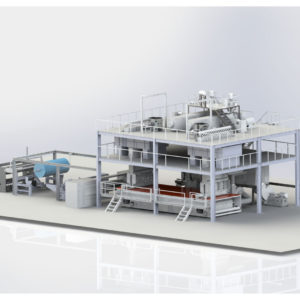The typical range of fabric weights and basis weights that can be achieved with PP Spunbond Machines can vary based on machine specifications and settings.
However, here is a general overview of the range:
Fabric Weights (Basis Weights):
- Lightweight Fabrics: PP Spunbond Machines are capable of producing lightweight spunbond nonwoven fabrics with basis weights as low as 10 grams per square meter (gsm) or even lower. These lightweight fabrics are often used in applications where a thin and breathable material is required, such as hygiene products and disposable clothing.
- Medium Weight Fabrics: Spunbond nonwoven fabrics with medium basis weights typically range from 15 gsm to 70 gsm. These fabrics are versatile and find use in various applications, including agriculture, packaging, and medical textiles.
- Heavyweight Fabrics: Some PP Spunbond Machines are capable of producing heavyweight spunbond nonwoven fabrics with basis weights exceeding 70 gsm. These fabrics are known for their strength and durability and are used in applications like geotextiles, construction materials, and industrial packaging.
Fabric Thickness:
- Thin Fabrics: The thickness of spunbond nonwoven fabrics is generally related to their basis weight. Thin fabrics produced by PP Spunbond Machines can have a thickness of less than 0.1 millimeters (mm). These thin materials are often used in applications that require flexibility and minimal bulk.
- Medium Thickness Fabrics: Spunbond nonwoven fabrics with medium thickness typically range from 0.1 mm to 0.3 mm. They offer a balance between strength and flexibility and find use in a wide range of applications.
- Thick Fabrics: Thick spunbond nonwoven fabrics, with a thickness exceeding 0.3 mm, are employed in applications that require cushioning, impact resistance, and insulation properties. They are used in various industrial and construction applications.
The specific basis weight and fabric thickness achieved with a PP Spunbond Machine can be adjusted by controlling factors such as polymer extrusion rate, line speed, and the design of the die or spinneret. Manufacturers customize their machines and processes to meet the requirements of their target products and industries, ensuring that spunbond fabrics are suitable for various applications, including those demanding lightweight, medium-weight, or heavyweight materials.
How does the machine control the extrusion and formation of continuous filaments from polypropylene (PP) resins?
PP Spunbond Machines control the extrusion and formation of continuous filaments from polypropylene (PP) resins through a series of processes that are carefully managed.
Here’s an overview of how the machine controls this intricate process:
- Polymer Extrusion: The process begins with the extrusion of polypropylene resin. Granules or pellets of PP resin are fed into an extruder, where they are heated and melted. The temperature and pressure in the extruder are precisely controlled to ensure that the resin is in a molten state and ready for extrusion.
- Spinneret Design: At the heart of the process is the spinneret. The spinneret is a specialized nozzle with numerous small holes, each corresponding to a filament. The design of the spinneret plays a critical role in controlling the filament properties, such as diameter and distribution. The spinneret is custom-designed to achieve the desired characteristics of the spunbond fabric.
- Filament Formation: The molten PP resin is forced through the spinneret, and as it exits the small holes, it undergoes rapid cooling and solidification. The result is the formation of continuous filaments that are extremely fine and uniform in diameter. The number of holes in the spinneret, their arrangement, and the extrusion rate determine the number of filaments and their size.
- Airflow and Quenching: Immediately after filament formation, a controlled airflow, often referred to as quench air, is directed onto the filaments. The quench air serves to further cool and solidify the filaments while maintaining their alignment. The precise management of airflow and temperature plays a role in filament quality.
- Laying Down the Web: The filaments are collected on a moving conveyor belt or drum in a random or controlled manner, creating a web of continuous filaments. PP Spunbond Machine The arrangement of filaments in the web is essential for fabric properties, including strength and uniformity.
- Bonding: To transform the web of filaments into a cohesive fabric, a bonding process is typically employed. This can involve various techniques, such as thermal bonding or chemical bonding. In thermal bonding, the fabric passes through heated calender rolls or an oven, where the filaments partially melt and fuse together at contact points. The pressure from the calender rolls further bonds the filaments.
- Cooling and Winding: After bonding, the fabric is cooled and then wound onto rolls for further processing or conversion into rolls of spunbond fabric.
The control of various parameters, including polymer temperature, extrusion rate, spinneret design, quench air temperature and flow, and bonding conditions, is essential to achieving the desired characteristics of the spunbond fabric. The combination of these factors allows PP Spunbond Machines to produce nonwoven fabrics with precise filament properties, basis weights, and thicknesses, tailored to specific applications.
